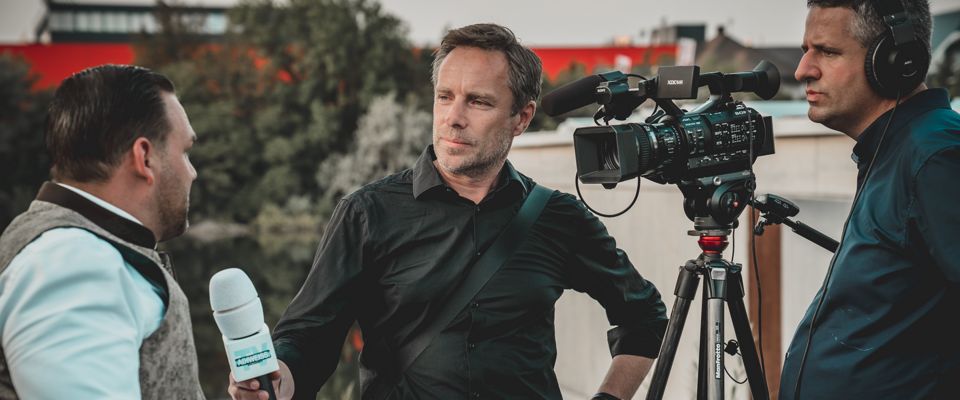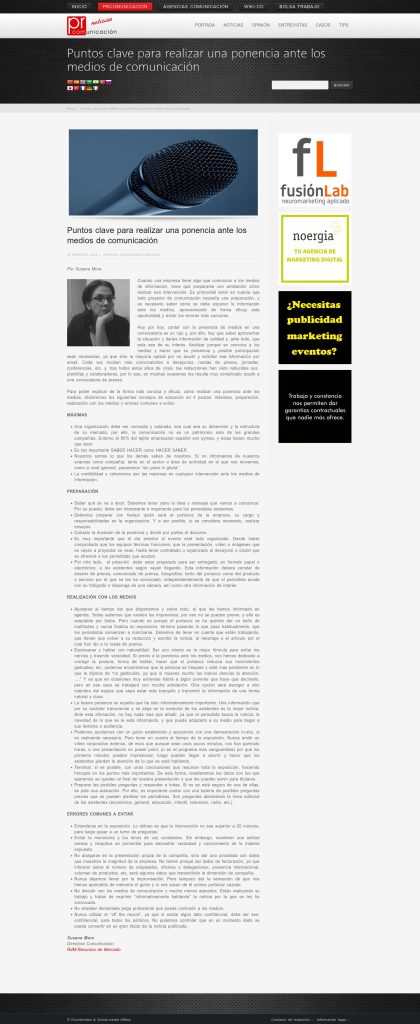 When a company has something to communicate to the media, it has to prepare in advance how to do so. It is essential to bear in mind that every communication project needs preparation, and it is necessary to know how to present the information to the media, making effective use of this opportunity and avoiding the most common mistakes.
When a company has something to communicate to the media, it has to prepare in advance how to do so. It is essential to bear in mind that every communication project needs preparation, and it is necessary to know how to present the information to the media, making effective use of this opportunity and avoiding the most common mistakes.
Nowadays, having the media present at an event is a luxury and, therefore, you have to know how to take advantage of the situation and provide them with quality information and, above all, make sure that it is of interest to them. Analyse why you are calling the media and make their presence and possible participation necessary, otherwise most of them will choose not to attend and request this information by email. They receive more and more invitations to breakfasts, press conferences, seminars, conferences, etc. and, after all these years of crisis, newsrooms have seen their staffs and collaborators reduced, so that, on many occasions, it is very difficult for them to attend a press conference.
In order to explain in the most concise and effective way, how to make a presentation to the media, we will divide the following tips into 4 guidelines: maximes, preparation, implementation with the media and common mistakes to avoid.
MAXIMES
 An organisation must be known and valued, regardless of its size and the structure of its market, which is why communication is not just a heritage of large companies. Around 80% of the Spanish business fabric are SMEs, and they have a lot to say.
An organisation must be known and valued, regardless of its size and the structure of its market, which is why communication is not just a heritage of large companies. Around 80% of the Spanish business fabric are SMEs, and they have a lot to say.- It is as important to KNOW HOW TO DO as it is to DO KNOWING.
- We are what others know about us. If we do not report on our progress as a company, both in the sector or area of activity in which we operate, as well as at a general level, we will pass “unnoticed”.
- Credibility and consistency are paramount in any media intervention.
PREPARATION
- Know what is going to be said. We must be clear about the idea or message we are going to communicate. Of course, it must be interesting and important for the journalists in attendance.
- We should prepare in advance who will be the spokesperson for the company, their position and responsibilities in the organisation. And if possible, if necessary, test rehearsals should be held.
- Calculate the length of the speech and divide the speech into parts.
- It is very important that everything is organised the day before the event. From having checked that the technical equipment is working, that the presentation, video or images to be projected can be seen, to having contracted or organised the breakfast or cocktail that will be offered to the journalists who will attend.
- On the other hand, the press-kit must be prepared to be handed out, in paper or electronic format, to the attendees as they arrive. This information should include a press kit, press release, photographs, both of the spokesperson and of the product or service for which they have been called, regardless of whether the journalist comes with his or her photographer or has a camera, as well as other information of interest.
REALISATION WITH THE MEDIA
- Adjust to the time we have available and, above all, to the time we have informed you of in the agenda. We all know that there are unforeseen events; that is why they cannot be foreseen, and that is acceptable to everyone. But when it is because the spokesperson has wanted to take a bath with the crowds and never finishes his or her presentation, what usually happens ends up happening is that the journalists start to leave. We must bear in mind that they are working, that they have to go back to their newsroom and write the news, the report or the article for which they have gone to the press conference.
- Express yourself and speak naturally. Being yourself is the best way to avoid nerves and transmit truthfulness. If, prior to the presentation to the media, we have spent time correcting the posture, way of speaking, making the spokesperson reduce their gestural movements, etc., we may find that the person is blocked and is more focused on what we told them “don’t gesticulate, because if you move your hands too much you divert attention, ….”. On very extreme occasions, there will be some speakers who need to be told this, but in this case we will work on it well in advance. Another option is to choose another member of the team who knows how to be calmer and convey the information in a natural and clear way.
- A good presentation is one that has been informatively important. Information that transcends and stays in the memory of the audience is the best news. Given this statement, there is nothing more to add, since the journalist is looking for the news, the novelty of what is being reported, and that he can adapt it to his medium in order to reach his readers or audience.
- We can help ourselves with a set script and support it with an on-site demonstration, if it is really necessary. But bear in mind the time of the presentation. Never broadcast a long corporate video, even if it is only a few minutes, it may seem like hours; or a power point presentation, (or the most avant-garde programme) because the first few minutes may be impressive, but then they can become boring and make the audience lose attention to what is being talked about.
- Finish, if possible, with conclusions that summarise the whole presentation, emphasising the most important points. In this way, we will highlight the data that we want them to keep at the end of our presentation and that they can use as headlines.
- Prepare possible questions and answer them all. If you are not sure about one of them, ask for clarification. For this reason, it is important to have a list of possible questions that journalists may ask you beforehand. These are questions according to the editorial line of the audience (economic, general, education, children’s, television, radio, etc.).
COMMON MISTAKES TO AVOID
- Extend the presentation. Ideally, the presentation should not exceed 20 minutes, followed by question time.
- Avoid monotony and constant tones of voice. However, maintaining a calm and receptive attitude is essential to demonstrate truthfulness and knowledge of the subject matter.
- Do not go into the presentation of the company itself, but give a quick brushstroke with data that show the magnitude of the company. It does not necessarily have to be turnover data, as information on the number of employees, offices or delegations, international presence, volume of products, etc., will be some data that will transmit the size of the company.
- Never let ourselves be carried away by improvisation. But neither should we give the impression that we have learnt the script by heart and if we are taken out of it we are the hunted spokesperson.
- Do not argue with the media, let alone attack them. They are doing their job and trying to squeeze “informatively speaking” the news for which they have been summoned.
- Do not use too much professional terminology that may confuse the media.
- Never use “off the record”, because if there is any confidential information, it should be confidential, for all audiences. We cannot control that at any given moment it can become a big headline in the published news.
Susana Moré Torres
Communications Director of Recursos de Mercado
Published on 26 april 2023 by the magazine:





